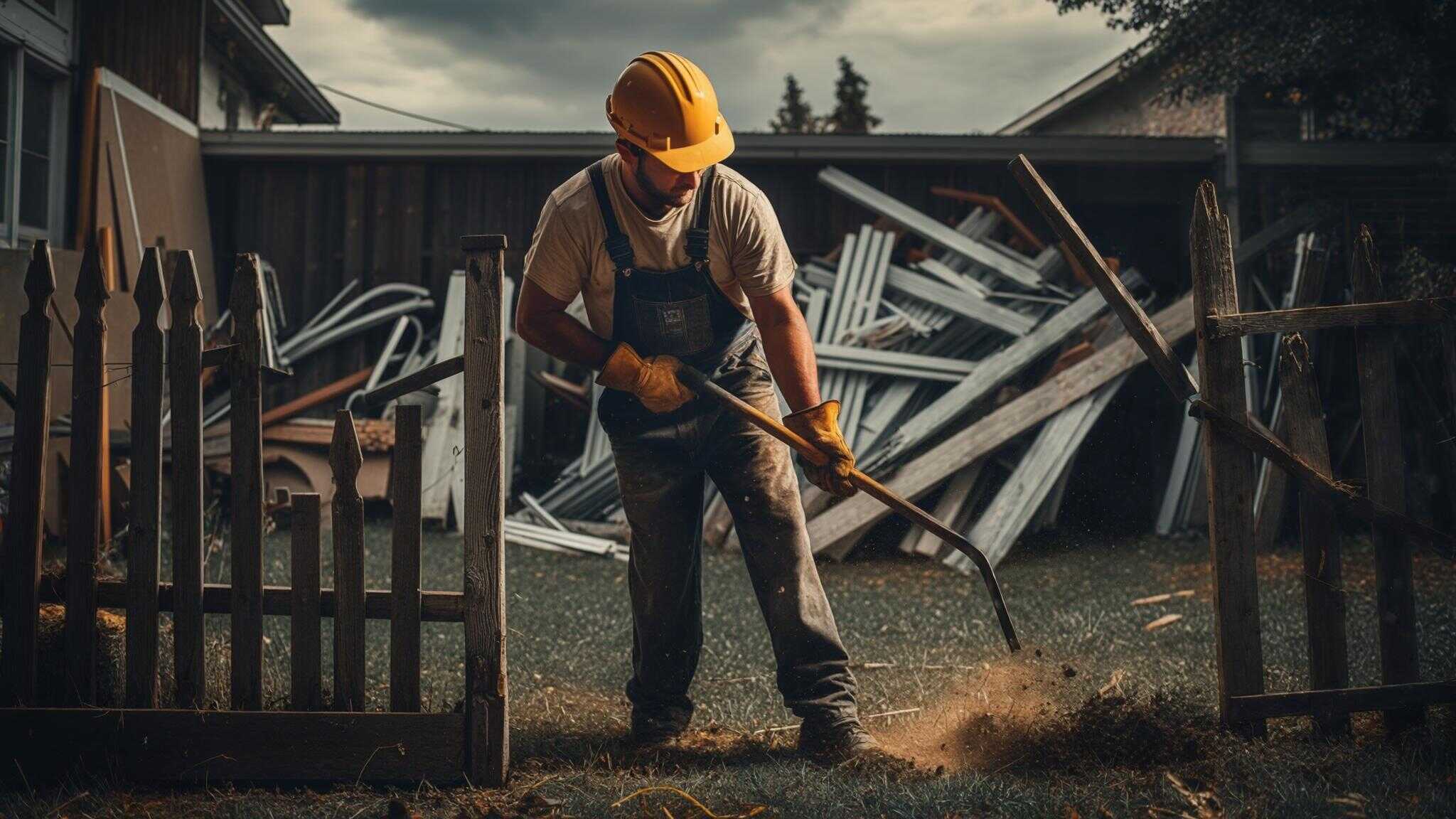Fence Removal Cost Secrets That Could Save You Thousands (What Contractors Don’t Want You to Know)
Most homeowners think fence removal is just about tearing down posts and hauling away debris, but I’ve discovered there’s a whole hidden world of strategic economics that can either cost you big or save you serious money. After diving deep into the real economics behind fence removal, I realized that understanding these insider secrets can transform what seems like a simple demolition job into a smart financial move that actually adds value to your property.
With the national average cost ranging from $600-$800 for fence removal projects according to Hometown Demolition Contractors, knowing these secrets becomes even more crucial for protecting your budget. Understanding the true economics of fence removal becomes even more important when you consider that scrap metal pickup for fencing can significantly offset your removal costs through proper material recovery strategies.
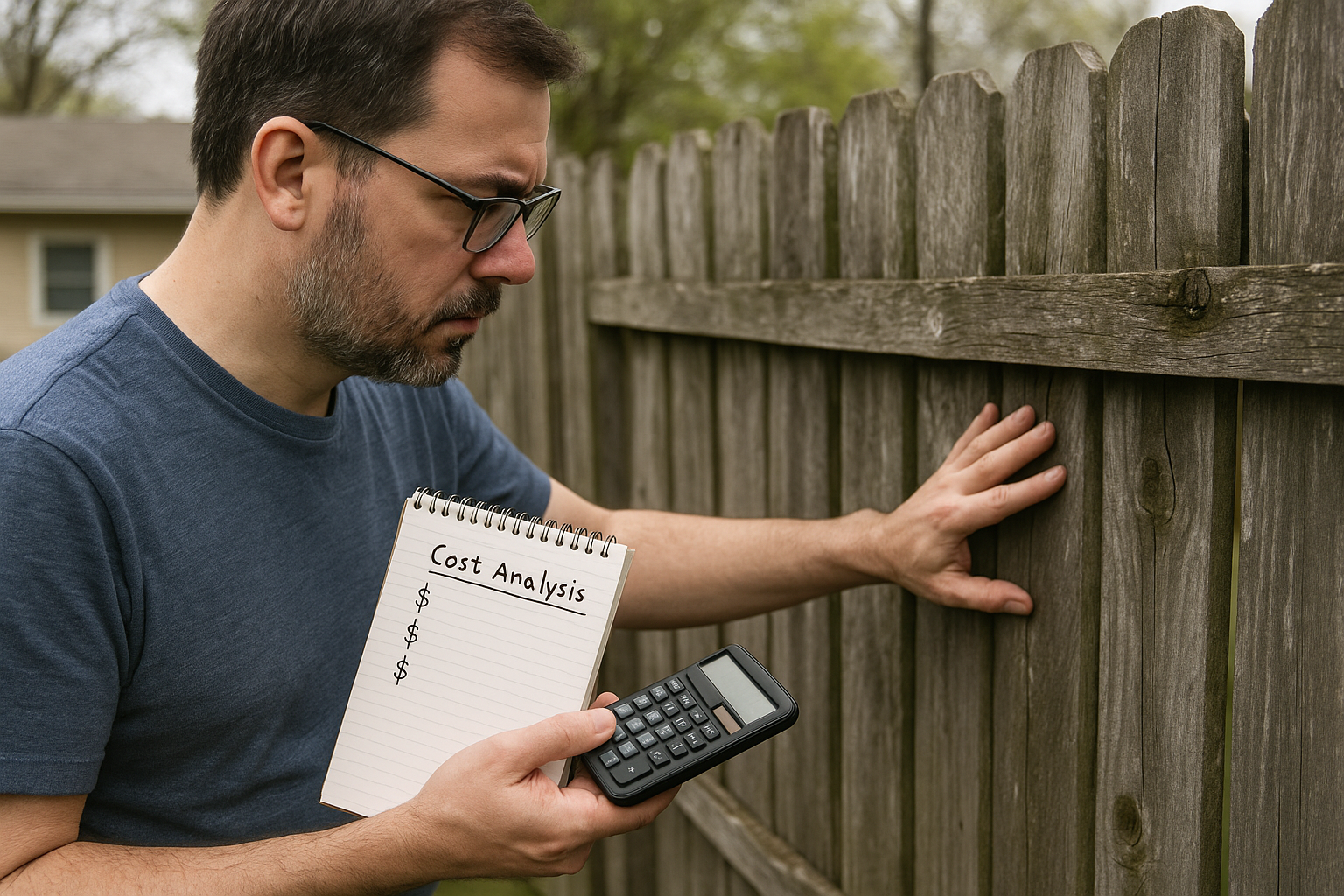
Table of Contents
- The Hidden Money-Making Opportunities in Your Old Fence
- Why Your Fence Removal Quote Might Be Missing Major Costs
- Smart Timing and Market Strategies That Cut Costs in Half
- How to Bundle Projects for Maximum Savings
TL;DR
- Your old fence materials might be worth hundreds or thousands in recovered value through scrap metal, reclaimed lumber, and proper recycling
- Hidden costs like utility conflicts, soil contamination, and permit requirements can double your fence removal expenses if you’re not prepared
- Timing your removal during off-peak seasons and coordinating with other projects can slash costs by 25-40%
- Different contractor types have massive efficiency gaps that create 60-80% cost differences for the same job
- Proper planning and material identification can turn environmental compliance from a cost burden into tax deductions and rebates
Get a Live Quote Now
Connect to a live representative and get a quote in real time for junk removal in your area.The Hidden Money-Making Opportunities in Your Old Fence
Before you let contractors haul away your old fence as “junk,” you need to understand that there’s real money sitting in those posts and panels. I’ve seen homeowners recover thousands of dollars through strategic material recovery, permit research, and timing decisions that most people completely miss. The key is shifting your mindset from “getting rid of waste” to “recovering hidden assets” that can offset your fence removal cost or even turn a profit.
Turning Your Fence Materials Into Cold Hard Cash
Different fence materials have dramatically different recovery values, and knowing what you’ve got can mean the difference between paying disposal fees and getting paid for your materials. Wood fencing, especially cedar or redwood, commands premium prices from reclaimed lumber dealers, while metal components often contain valuable scrap materials that recycling centers will pay top dollar for.
Professional fence removal typically costs between $3 and $10 per linear foot according to Ergeon, but understanding material recovery can significantly offset these expenses. When you factor in the fence removal cost per foot against potential material recovery, the economics change dramatically.
| Fence Material | Recovery Value per Linear Foot | Typical Removal Cost | Net Cost After Recovery |
|---|---|---|---|
| Cedar/Redwood Wood | $2-8 | $3-5 | $1-3 (or profit) |
| Chain Link (Galvanized) | $1-3 | $6-8 | $3-7 |
| Vinyl/PVC | $0.50-1 | $5-10 | $4-9.50 |
| Wrought Iron | $3-6 | $6-8 | $0-5 |
| Pressure-Treated Wood | $0.50-2 | $1-5 | $1-4.50 |
The Surprising Value Hidden in Common Fence Materials
That chain link fence you think is worthless? It’s actually galvanized steel that recyclers pay premium rates for. Wooden privacy fences, particularly those made from cedar, redwood, or pressure-treated lumber, can fetch $2-8 per linear foot from reclaimed lumber dealers. Even vinyl fencing has recycling value, though you’ll need to find specialized processors who can handle PVC materials properly.
Sarah from Denver discovered her 150-foot cedar privacy fence was worth $900 in reclaimed lumber value. After factoring in the $450 removal cost, she actually made $450 profit on her fence removal project by connecting with a local reclaimed lumber dealer who picked up the materials directly from her property.
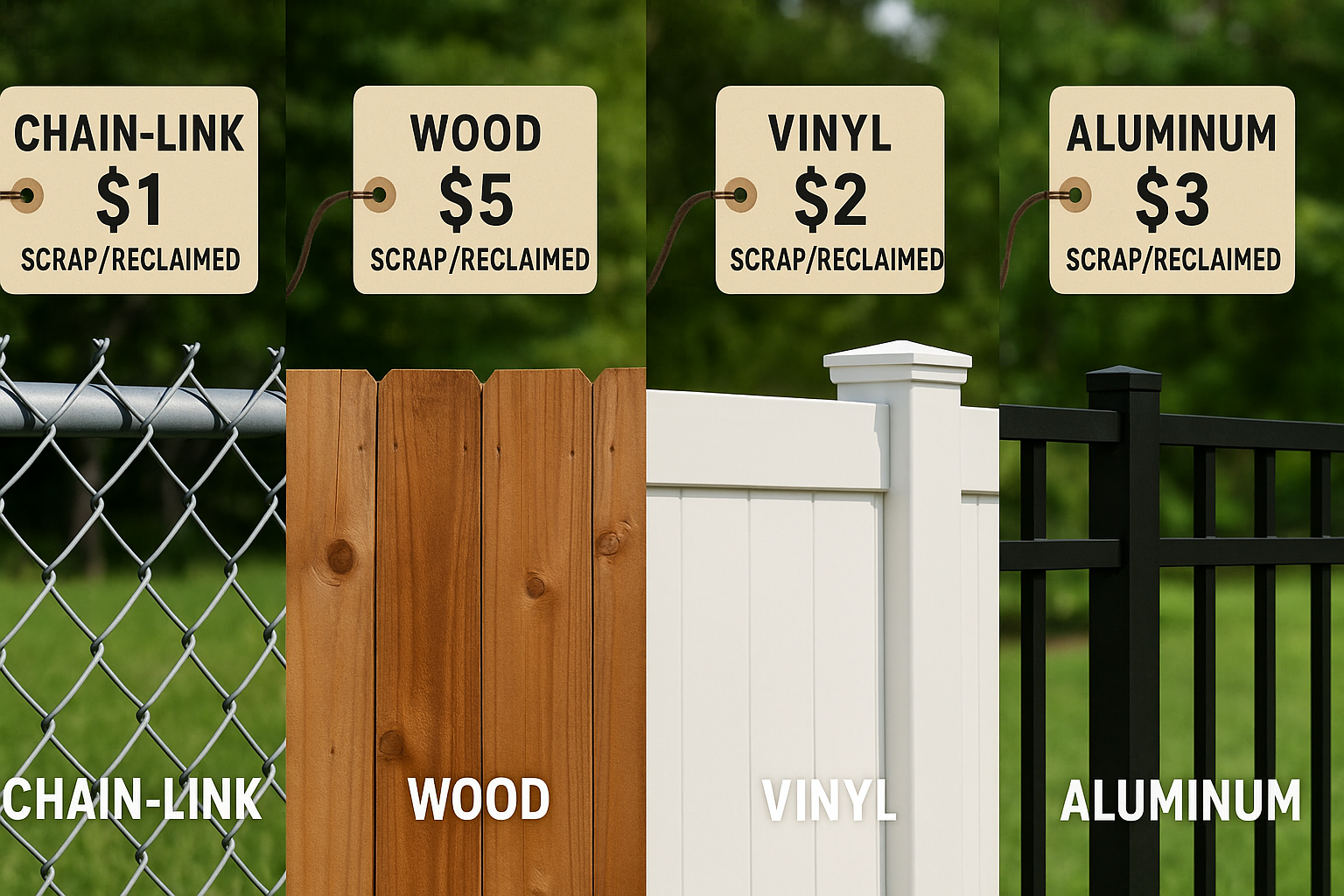
Uncovering Property Secrets Through Permit Detective Work
Removing fences often reveals forgotten property line disputes, easement issues, or permit violations that have been hiding for years. I call this “permit archaeology” because you’re literally uncovering your property’s legal history.
Resolving these issues during removal can prevent costly legal problems down the road and actually increase your property value by clearing title complications that could derail future sales. Have you ever wondered what legal surprises might be lurking beneath your fence line?
Why Timing Your Removal Can Make or Break Your Budget
The difference between peak season and off-season fence removal can be 20-30% in labor costs alone. I’ve found that scheduling removal during late fall or early spring (when contractors are hungry for work) delivers the best rates.
Plus, coordinating with other property improvements eliminates duplicate mobilization fees that can add hundreds to your total cost. Smart homeowners treat fence removal timing as a strategic financial decision, not just a convenience issue.
Navigating the Regulatory Maze Without Getting Burned
Fence removal isn’t just about physical demolition – there’s a complex web of local regulations, HOA requirements, and environmental considerations that can either cost you big or create unexpected savings opportunities. Understanding these rules upfront prevents costly surprises and sometimes unlocks rebates or tax benefits you didn’t know existed.
The trend toward strategic fence replacement is gaining momentum, as seen in Portland where “new fencing to prevent homeless camping at 1 site in Portland will cost $900K” according to The Oregonian. This demonstrates how municipalities are investing heavily in fence infrastructure, creating opportunities for homeowners to time their removal projects when contractors have equipment in the area. When you’re considering the cost to install a fence, these municipal projects can actually work in your favor.
Municipal Codes That Can Save You Money (Not Just Cost You)
Many municipalities require permits for fence removal, especially for fences over six feet or those near property lines. However, these same codes often provide expedited processes for safety-related removals or environmental improvements.
I’ve seen homeowners get their permit fees waived and processing time cut in half by framing their removal as a safety or environmental improvement project. The trick is understanding how to position your project within existing municipal incentive programs.
Environmental Compliance as a Profit Center
Older fences containing treated lumber with arsenic or lead-based paints create hazardous waste disposal requirements that sound expensive. But here’s what most people don’t know: proper documentation of environmental compliance can qualify for tax deductions and sometimes municipal rebates for responsible disposal.
The key is working with contractors who understand these programs and can help you access them. I’ve watched homeowners turn what looked like expensive compliance costs into actual tax savings.

Why Your Fence Removal Quote Might Be Missing Major Costs
Standard fence removal quotes often look deceptively simple, but I’ve learned that the real costs hide in technical complexities that can multiply your expenses. Underground utilities, soil contamination, and specialized disposal requirements aren’t usually included in basic quotes, yet they can easily double or triple your final bill if you’re not prepared for them.
When contractors give you that initial fence removal cost estimate, they’re usually calculating based on perfect conditions that rarely exist in real-world projects. The question becomes: how much does fence removal cost when you factor in all the hidden complications?
Underground Surprises That Blow Up Budgets
Modern properties have complex networks of utilities, irrigation systems, and foundation elements that weren’t considerations when older fences were installed. These underground conflicts create some of the biggest surprise costs in fence removal projects, but they’re also the most preventable if you know what to look for.
The average cost of fence removal can range from $4-$10 per linear foot according to Fence Removal Service, but unexpected underground complications can easily push costs beyond this range. Understanding these hidden costs becomes crucial when you consider that construction debris removal often involves similar underground complications that can significantly impact your project budget.
Beyond “Call Before You Dig” – The Hidden Utility Networks
Standard utility location services only cover major gas, electric, and water lines. Your property likely has low-voltage lighting systems, irrigation controls, fiber optic cables, and security system wiring that won’t show up on utility maps. Professional contractors use specialized detection equipment to find these systems, but many budget contractors skip this step and end up causing expensive damage.
Mike’s fence removal project in suburban Atlanta went from a quoted $800 to $2,400 when the contractor accidentally severed his underground sprinkler system and landscape lighting cables. The utilities weren’t marked because they were installed after the original utility mapping, creating $1,600 in unexpected repair costs.
Root Systems and Soil Stability Issues Nobody Talks About
Mature landscaping around fence lines creates extensive root systems that can destabilize soil when disturbed during removal. I’ve seen simple fence removal projects turn into major erosion control and landscape restoration jobs because nobody assessed the root situation beforehand.
Professional soil stability analysis costs a few hundred upfront but can prevent thousands in remediation costs. The fence removal cost per foot suddenly becomes irrelevant when you’re dealing with major soil stabilization issues.
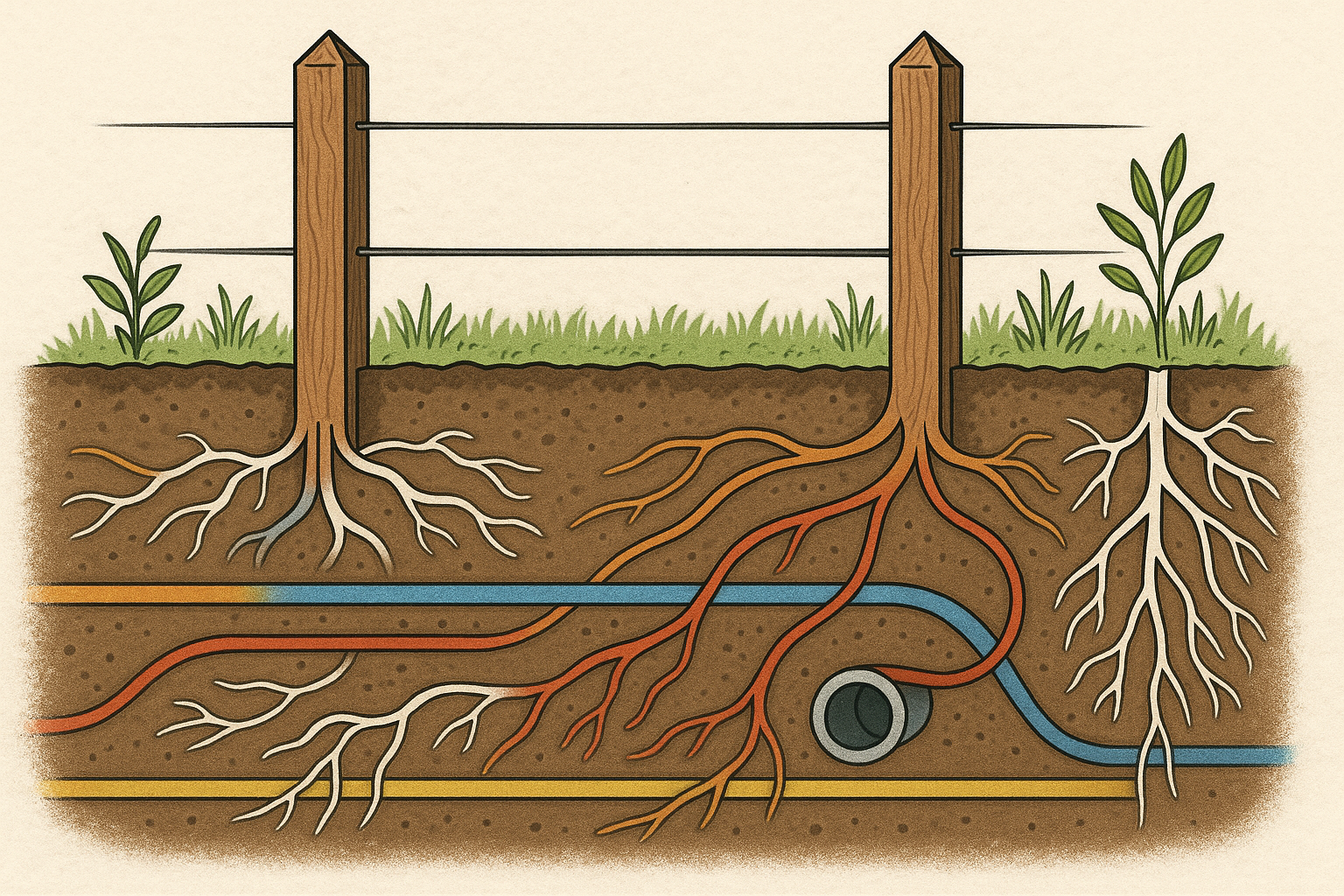
Specialized Disposal Costs That Catch Everyone Off Guard
Different fence materials require increasingly specialized disposal methods due to environmental regulations. What looks like standard construction debris might actually be classified as hazardous waste, creating disposal costs that range from minimal to extremely expensive depending on your fence’s age and composition.
When Your Old Fence Becomes Hazardous Waste
Fences installed before 1990 often contain materials now classified as hazardous waste, including pressure-treated lumber with arsenic compounds and metal components with lead-based coatings. Proper identification and handling requires specialized contractors and disposal facilities that charge premium rates.
The good news? Knowing this upfront allows you to budget properly and find contractors who can handle it correctly. I’ve seen too many homeowners get blindsided by hazardous waste disposal fees that weren’t mentioned in the original quote.
Soil Contamination From Long-Term Fence Installation
Long-term fence installations can create soil contamination from wood preservatives, metal stains, and corrosion byproducts. When removal disturbs these areas, soil testing and potential remediation become necessary. Standard removal quotes don’t anticipate these costs, but they can add thousands to your project if contamination is discovered during work.
Pre-Removal Checklist:
- Identify fence installation date and materials used
- Request utility location for all services (including private utilities)
- Assess mature landscaping and root systems near fence line
- Check local permit requirements and HOA restrictions
- Research material recovery opportunities in your area
- Get soil testing if fence is over 30 years old
- Document fence condition with photos for insurance purposes
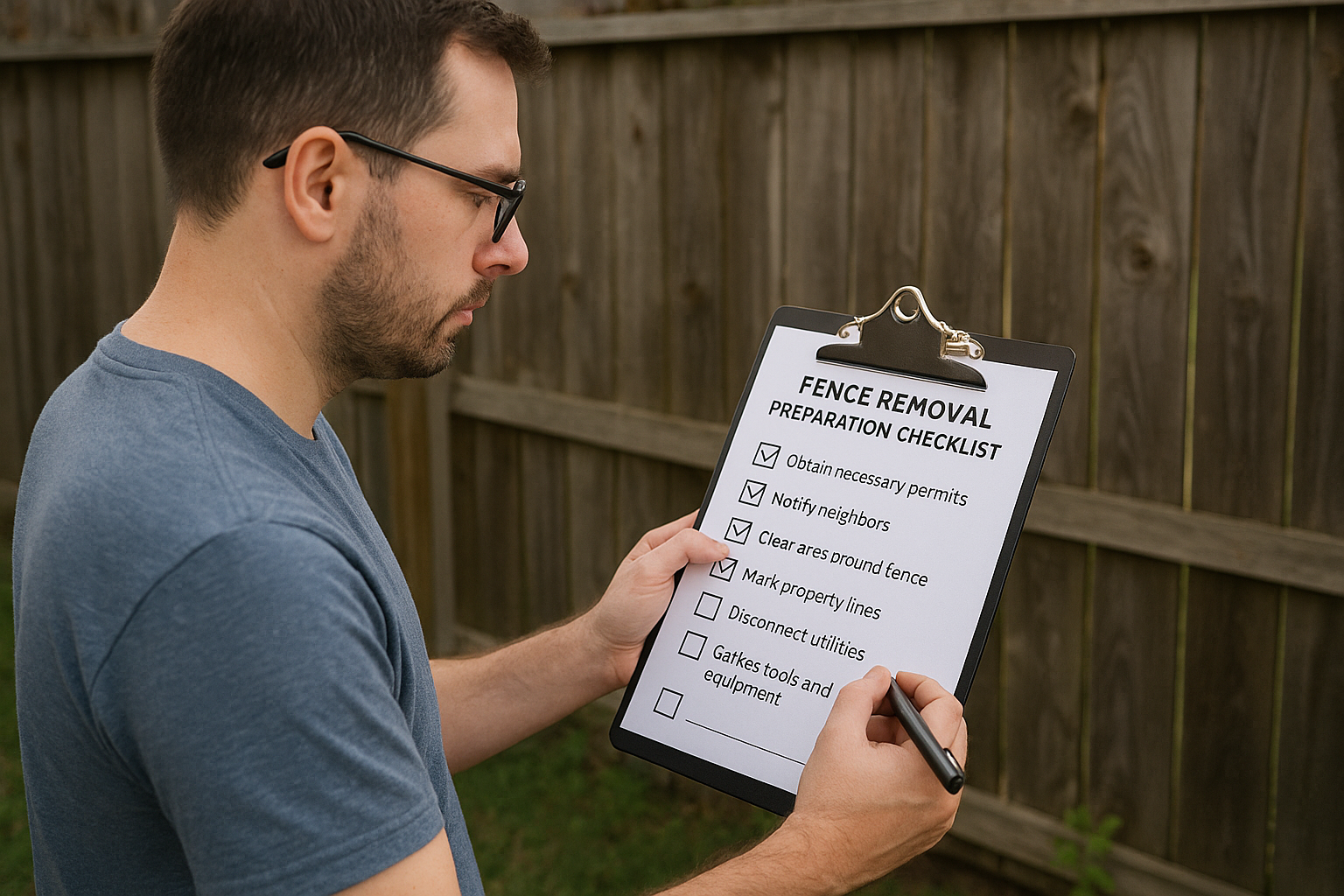
Smart Timing and Market Strategies That Cut Costs in Half
Fence removal costs fluctuate dramatically based on seasonal demand, local construction activity, and contractor availability. I’ve discovered that understanding these market dynamics and timing your project strategically can reduce costs by 25-40% without sacrificing quality. The key is thinking like a savvy consumer who understands supply and demand cycles.
Most homeowners approach fence removal cost as a fixed expense, but I’ve learned it’s actually one of the most variable home improvement costs you’ll encounter. Smart timing can literally save you thousands.
Contractor Types and the Efficiency Gap Nobody Mentions
The fence removal market includes everyone from general handymen to specialized demolition crews, with massive differences in efficiency, equipment access, and final costs that aren’t obvious from initial quotes. Understanding these differences helps you choose the right contractor type for your specific project and budget.
Barbed wire fences are particularly challenging, typically costing $10-$14 per linear foot to remove and dispose of according to Fence Removal Service, highlighting how specialized materials require specialized expertise. The barbed wire fence removal cost reflects the additional safety equipment and disposal requirements these projects demand.
When you’re calculating fence removal cost per foot, contractor type makes a massive difference in both efficiency and final pricing.
Specialized Equipment That Changes Everything
Professional fence removal contractors have access to pneumatic post pullers, concrete breakers, and other specialized equipment that can reduce labor time by 60-80% compared to manual methods. These tools come with higher hourly rates, but the time savings often result in lower total costs for complex projects.
The trick is understanding when specialized equipment pays for itself and when manual methods are more cost-effective. I’ve watched homeowners pay premium rates for specialized equipment on simple projects where manual removal would have been faster and cheaper.
| Contractor Type | Hourly Rate | Equipment Access | Best For | Typical Efficiency |
|---|---|---|---|---|
| General Handyman | $30-50/hr | Basic tools only | Small wood fences | Manual labor intensive |
| Landscaping Crew | $40-70/hr | Some power tools | Fence + yard work | Moderate efficiency |
| Demolition Specialist | $60-100/hr | Professional equipment | Complex/large projects | High efficiency |
| Fencing Contractor | $50-80/hr | Specialized tools | Any fence type | Optimal efficiency |
| Junk Removal Service | $35-60/hr | Disposal trucks | Simple removals | Variable efficiency |
Insurance and Liability Costs Hidden in Every Quote
Fence removal involves significant risks from property damage, utility strikes, and worker injuries. Different contractors handle insurance very differently, and these differences show up in your final costs.
Uninsured contractors might quote lower rates, but they’re passing liability risk to you. Fully insured contractors cost more upfront but protect you from potentially massive liability exposure. I always tell homeowners that the cheapest quote often becomes the most expensive mistake.
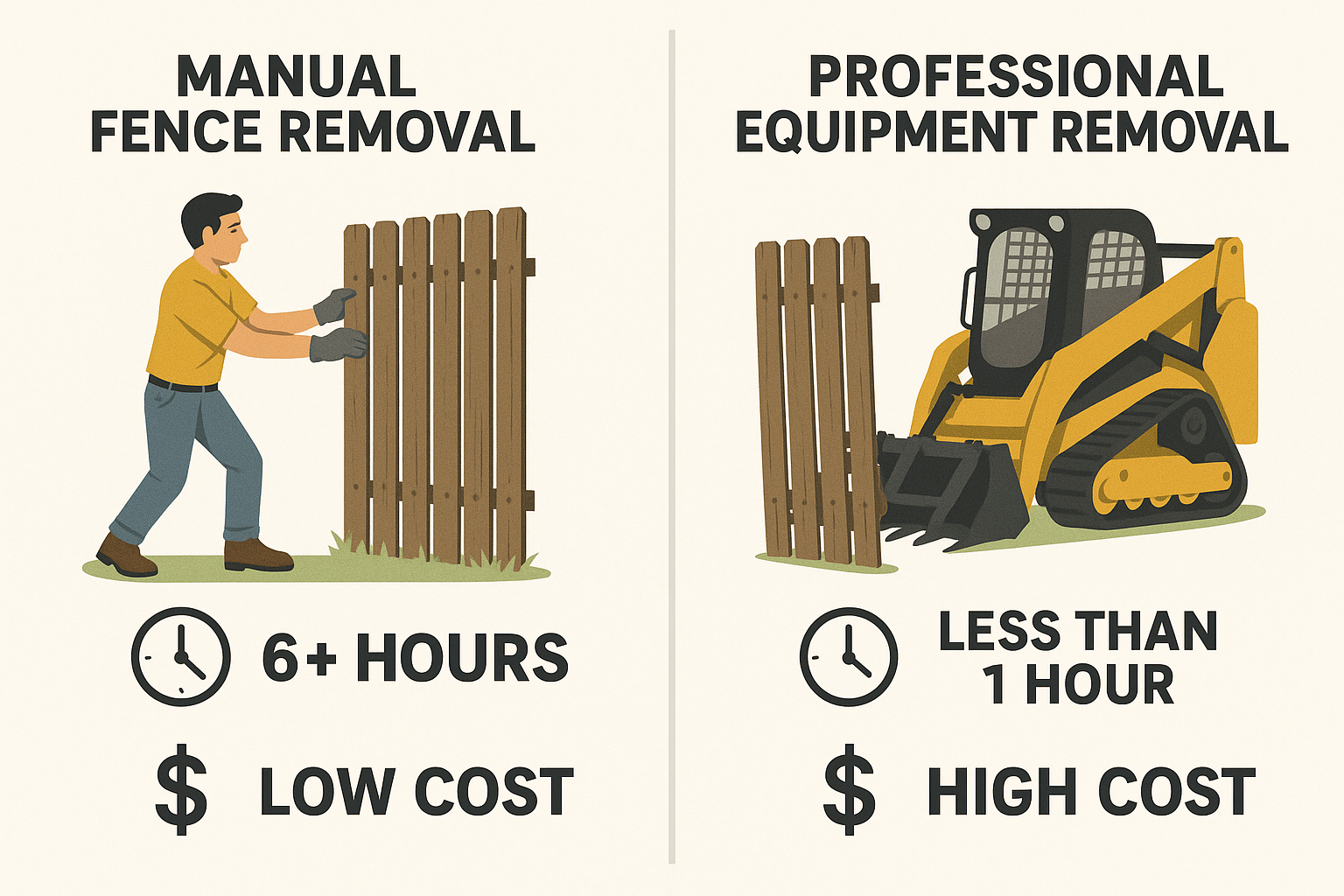
Seasonal Timing Strategies That Actually Work
Construction season timing affects fence removal costs through equipment availability, labor demand, and weather considerations. Understanding these cycles helps you predict optimal timing for removal projects and negotiate better rates when contractors need work.
International fence removal projects are scaling up significantly, as demonstrated by Jamaica’s “Mount Salem zinc fence removal to cost $26 million” according to Loop News. This massive infrastructure project shows how fence removal has become a major economic sector, creating opportunities for homeowners to leverage contractor availability during slower periods.
When you’re planning fence replacement cost into your budget, timing becomes even more critical since you’re coordinating both removal and installation.
Construction Season Arbitrage Opportunities
Peak construction season ensures equipment availability and faster project completion, but you’ll pay premium rates for the convenience. Off-season removal offers significantly lower rates (sometimes 30-40% less), but you might face weather delays and limited contractor availability.
The sweet spot is often late fall or early spring when contractors are transitioning between busy seasons. I’ve found that contractors are most willing to negotiate during these transition periods because they’re trying to keep crews busy.
Local Economic Factors That Drive Pricing
Regional economic conditions, including new construction activity and housing market trends, directly impact fence removal costs through labor availability and equipment demand. Areas with booming construction markets have higher removal costs due to competition for contractors, while slower markets offer opportunities for better rates and more flexible scheduling.
Jennifer in Phoenix saved $1,200 on her fence removal by scheduling it during the slow construction period in January. The same contractors who quoted $3,000 in peak season offered the identical service for $1,800 during their slow period, demonstrating how timing can create substantial savings.
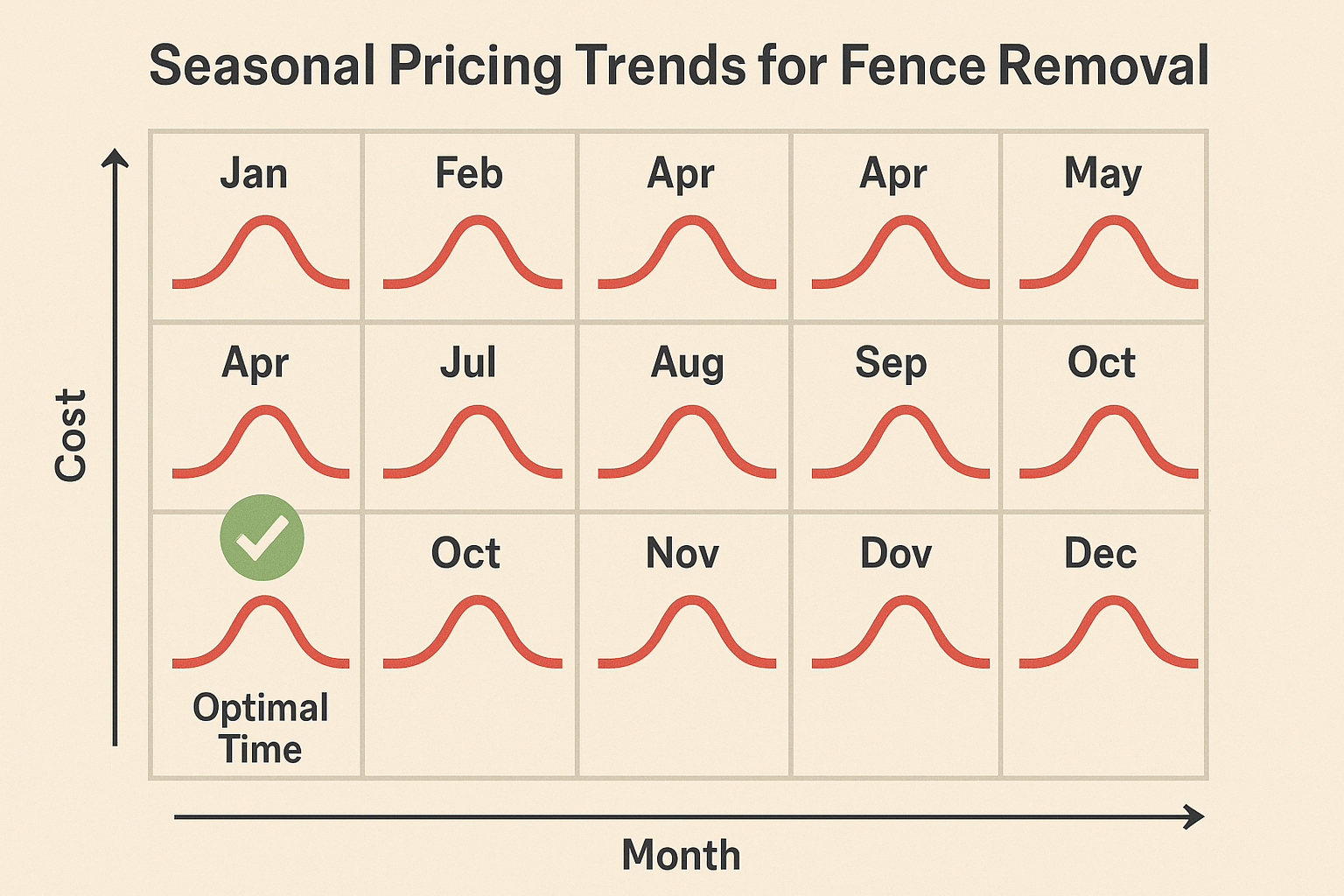
How to Bundle Projects for Maximum Savings
The most cost-effective fence removal projects integrate with other property improvements, creating synergies that reduce total costs while maximizing property value improvements. I’ve found that coordinating fence removal with landscaping, construction, or other property work can eliminate duplicate costs and create more comprehensive improvements for less money overall.
Smart homeowners understand that fence removal cost becomes much more manageable when it’s part of a larger property improvement strategy. The key is identifying which projects complement each other and create genuine cost savings.
Multi-Project Coordination That Actually Saves Money
Combining fence removal with other property improvements allows for shared mobilization costs, equipment rental, and waste disposal that would be much more expensive if handled separately. The key is understanding which projects complement each other and how to coordinate timing for maximum savings.
When planning coordinated projects, consider that construction waste disposal can be streamlined across multiple projects, reducing overall disposal costs significantly.
Landscape Renovation Integration Strategies
Combining fence removal with landscape renovation creates opportunities for coordinated soil management, plant relocation, and irrigation system modifications. Instead of paying separate mobilization fees for fence removal and landscaping crews, integrated projects can share equipment, labor, and disposal resources while creating more cohesive property improvements.
I’ve watched homeowners save 30-40% on total project costs by coordinating fence removal with major landscaping work. The shared equipment and labor costs create genuine economies of scale that benefit both projects.
Project Bundling Optimization Template:
Phase 1: Assessment & Planning
- List all planned property improvements for next 2 years
- Identify projects that share equipment or labor needs
- Calculate individual vs. bundled contractor quotes
- Map optimal sequencing for maximum efficiency
Phase 2: Contractor Coordination
- Find contractors who offer multiple services
- Negotiate bulk pricing for combined work
- Establish single point of contact for project management
- Coordinate permits and inspections across all projects
Phase 3: Execution & Savings Tracking
- Document actual savings vs. individual project costs
- Monitor quality across all bundled services
- Track timeline efficiency improvements
- Evaluate contractor performance for future projects
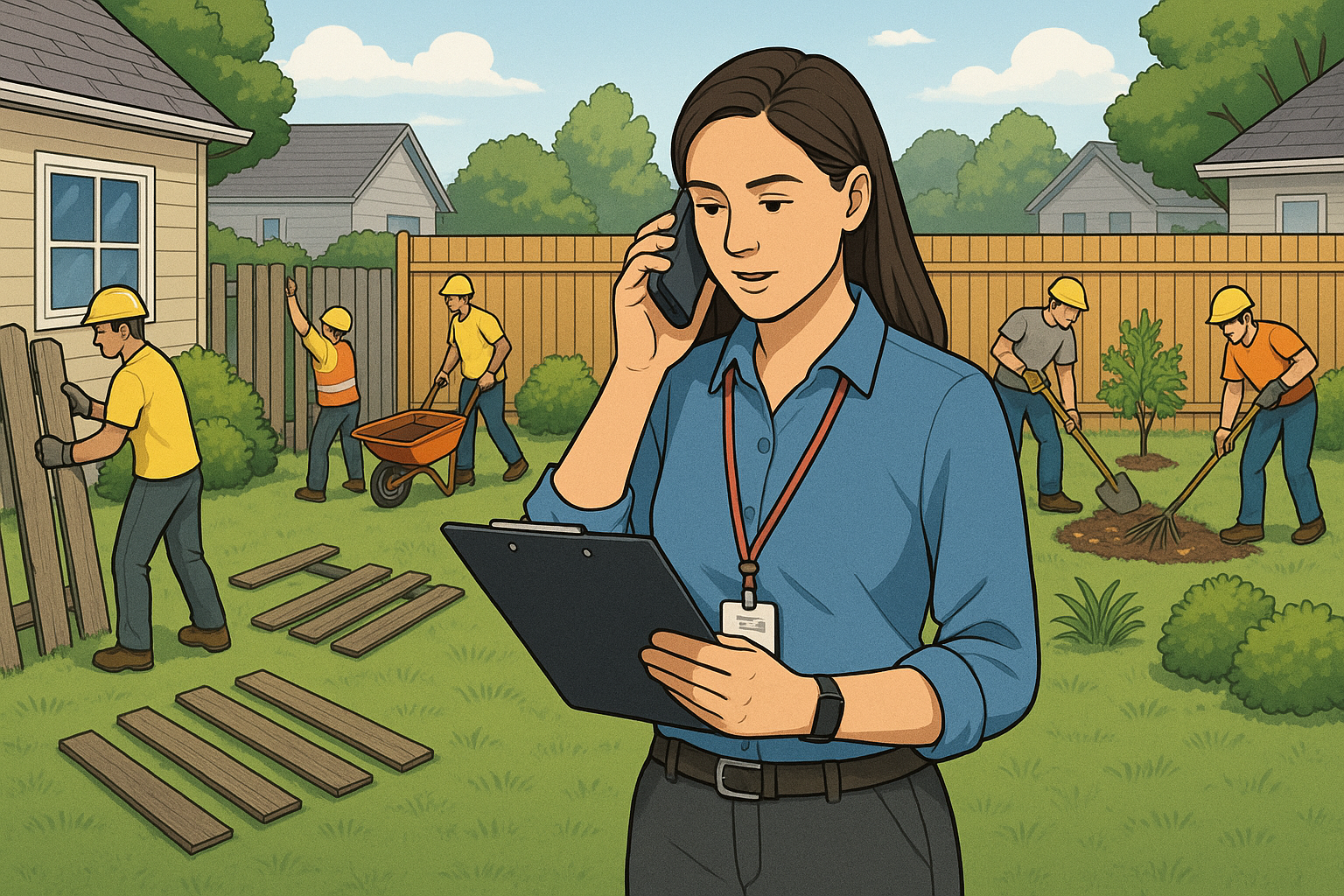
Construction Project Synergies That Multiply Savings
When fence removal is part of larger construction projects, the costs can often be absorbed into the overall project budget at reduced rates. Shared equipment rentals, coordinated waste disposal, and bulk material handling create economies of scale that benefit both the fence removal and construction portions of your project.
The most successful bundled projects I’ve seen involve homeowners who planned their fence removal around major construction or renovation work. The shared infrastructure costs create savings that wouldn’t be possible with standalone projects.
Long-Term Property Planning That Prevents Future Costs
Strategic fence removal should align with your long-term property development plans, considering future construction, landscape maturation, and changing family needs. This forward-thinking approach prevents costly future modifications and ensures your fence removal investment supports your overall property goals.
Long-term planning becomes essential when you consider that demolition waste removal costs can be minimized through strategic timing and coordination with other property improvements.
Future Construction Considerations That Save Thousands
Removing fences with future construction in mind eliminates the need for temporary removal and reinstallation, which can easily cost thousands in duplicate work. Planning fence removal as part of a multi-year property development strategy also provides opportunities to upgrade property boundaries, access points, and utility routing during the removal process.
I’ve seen homeowners save $5,000-$10,000 by coordinating fence removal with planned additions or major renovations. The key is thinking beyond the immediate removal project to understand how it fits into your property’s long-term development.
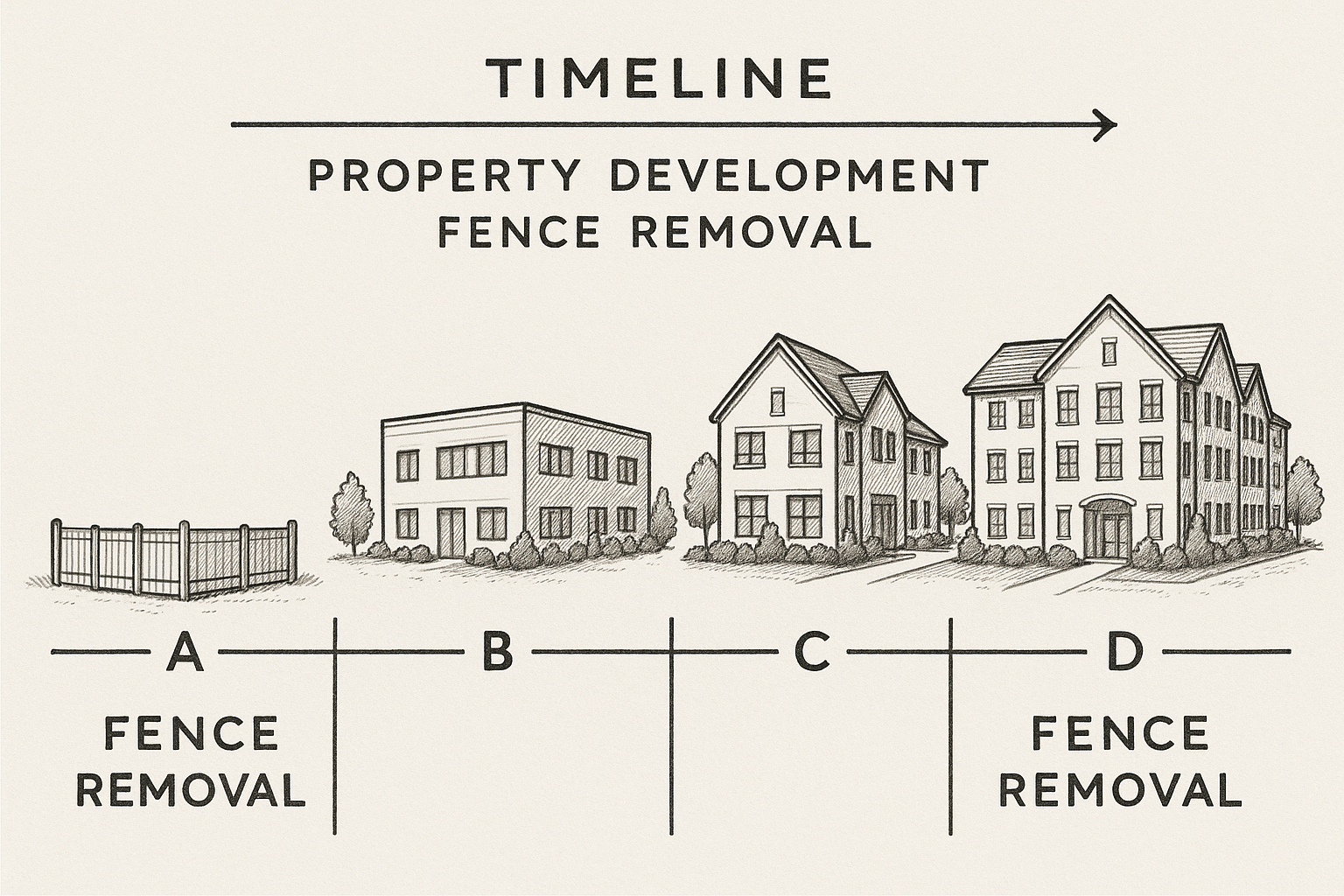
When you’re ready to tackle your fence removal project, JiffyJunk’s comprehensive approach addresses many of these hidden complexities and cost multipliers. Their experienced team understands the regional factors that impact removal costs and timing, plus they handle material recovery and environmental compliance that can offset your project costs. Most importantly, their full-service approach eliminates the need to coordinate multiple contractors while ensuring you get maximum value from your fence removal investment.
JiffyJunk’s expertise in debris removal ensures that your fence removal project is handled efficiently and cost-effectively, with proper attention to material recovery and environmental compliance.
Ready to turn your fence removal into a smart financial move? Contact JiffyJunk today for a comprehensive assessment that identifies all the hidden value and cost-saving opportunities in your project.
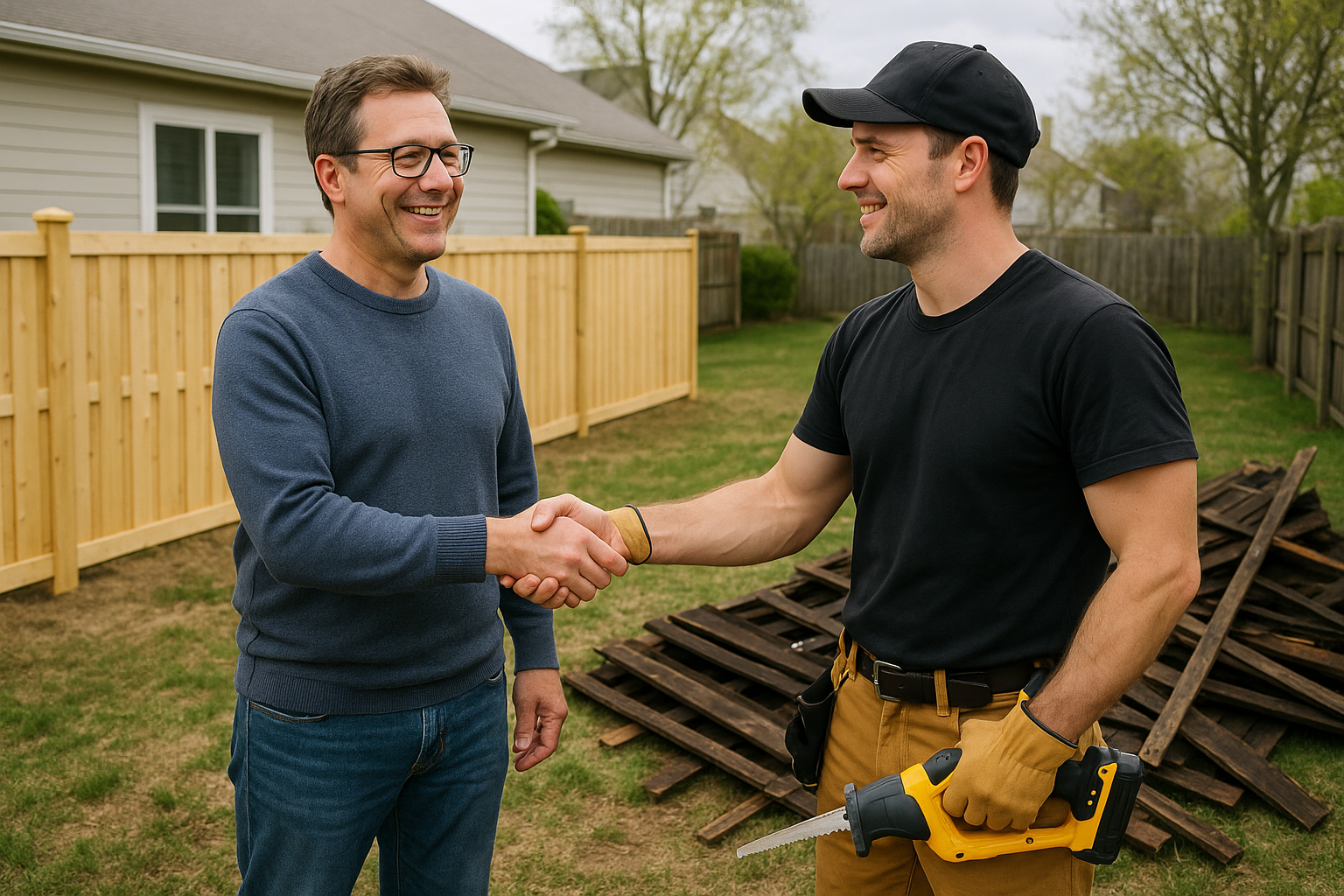
Final Thoughts
Fence removal doesn’t have to be just another expensive home maintenance task. With the right knowledge and strategic approach, you can transform it into a value-generating project that improves your property while keeping more money in your pocket.
The key is understanding that every fence removal project has hidden opportunities – whether that’s recovering valuable materials, timing the market for better rates, or coordinating with other improvements for maximum efficiency. Don’t let contractors treat your project as simple demolition when it could be so much more profitable and strategic for your property’s future.
Understanding fence removal cost as a strategic investment rather than just an expense changes everything about how you approach these projects. I’ve watched too many homeowners miss opportunities to turn removal costs into actual profit simply because they didn’t know these secrets existed.
